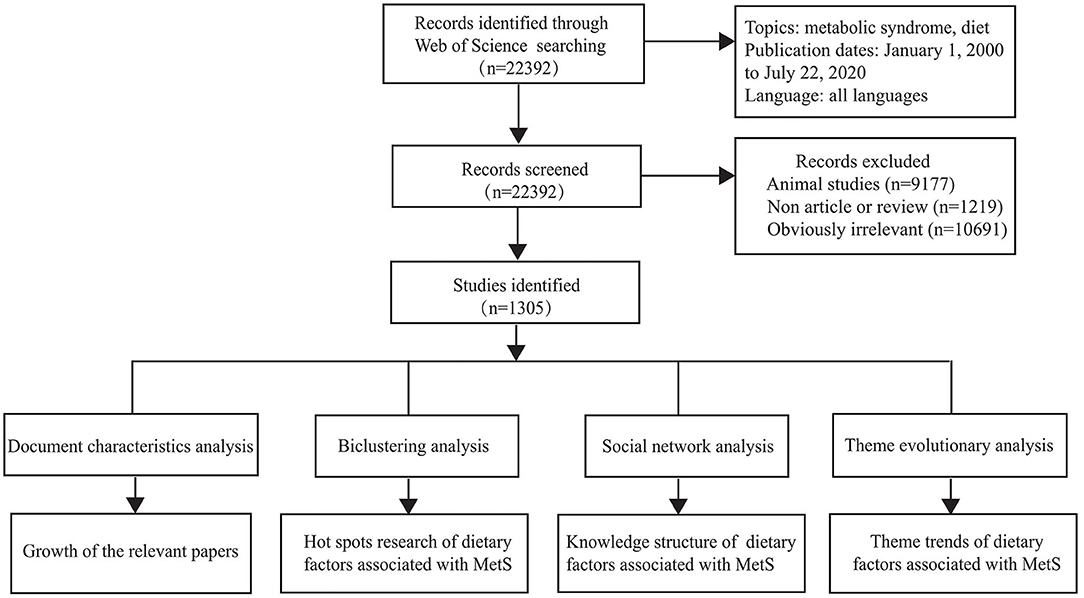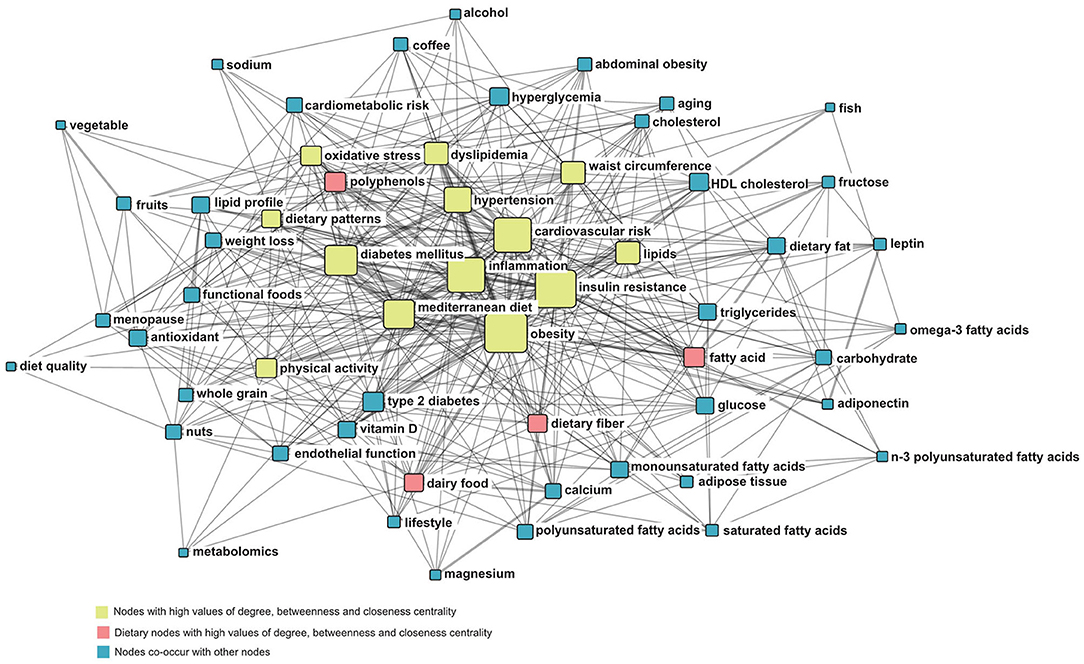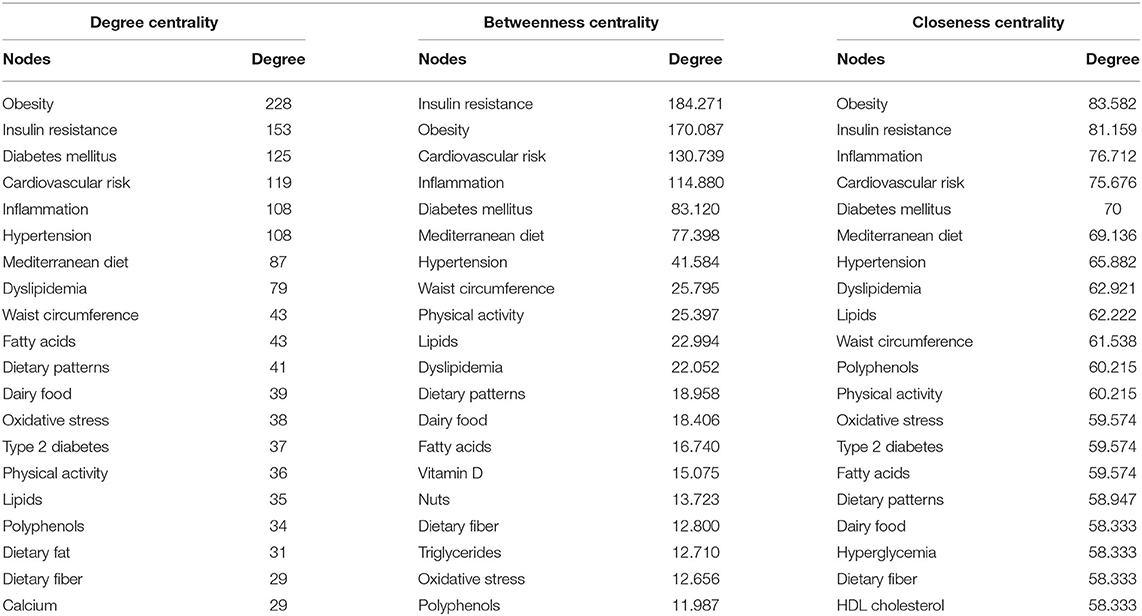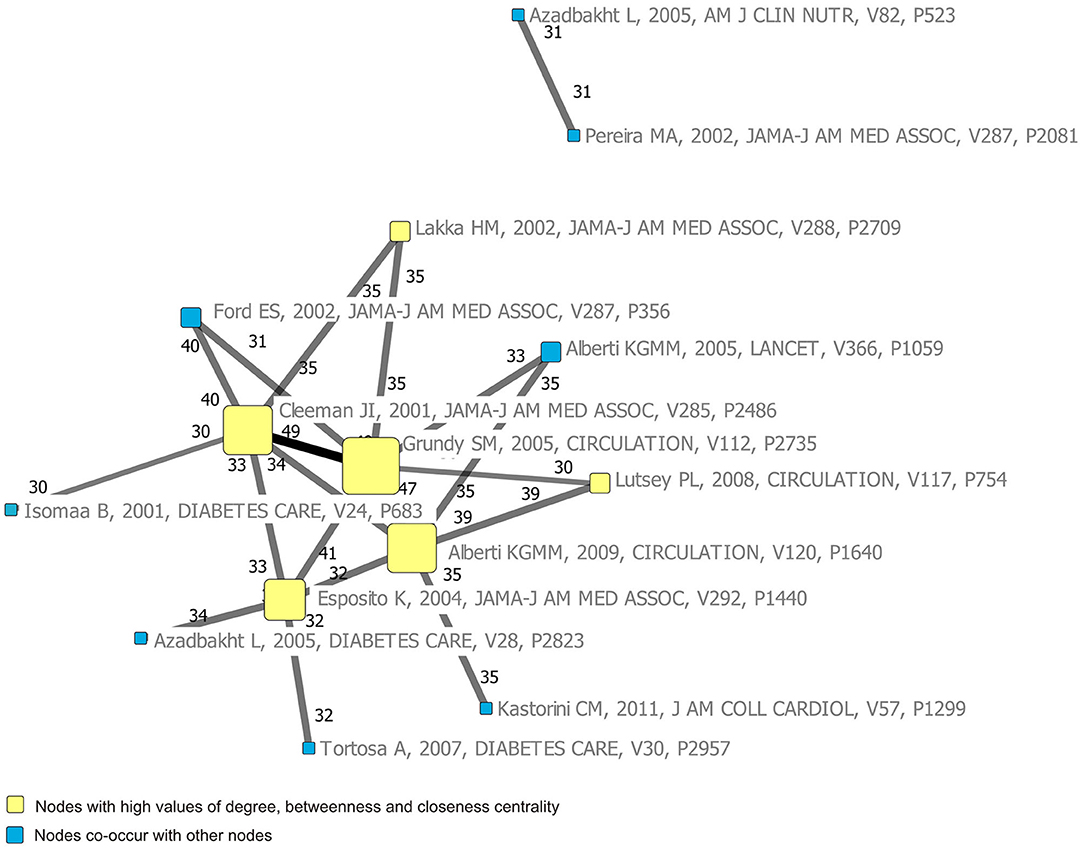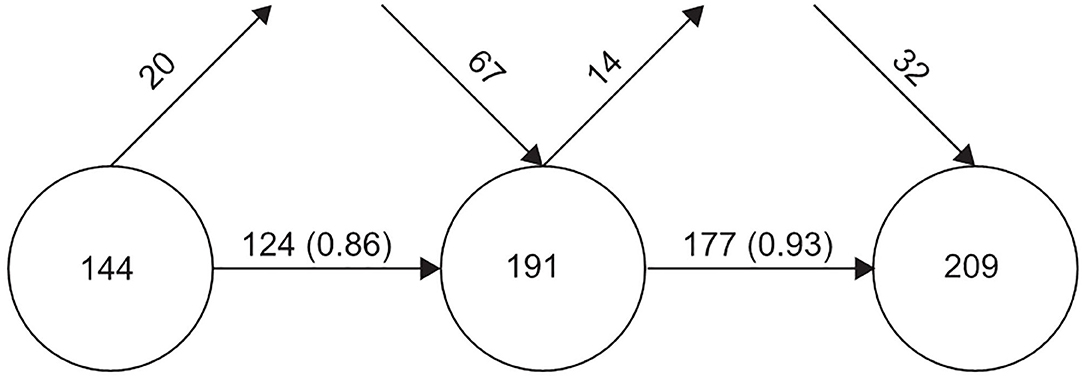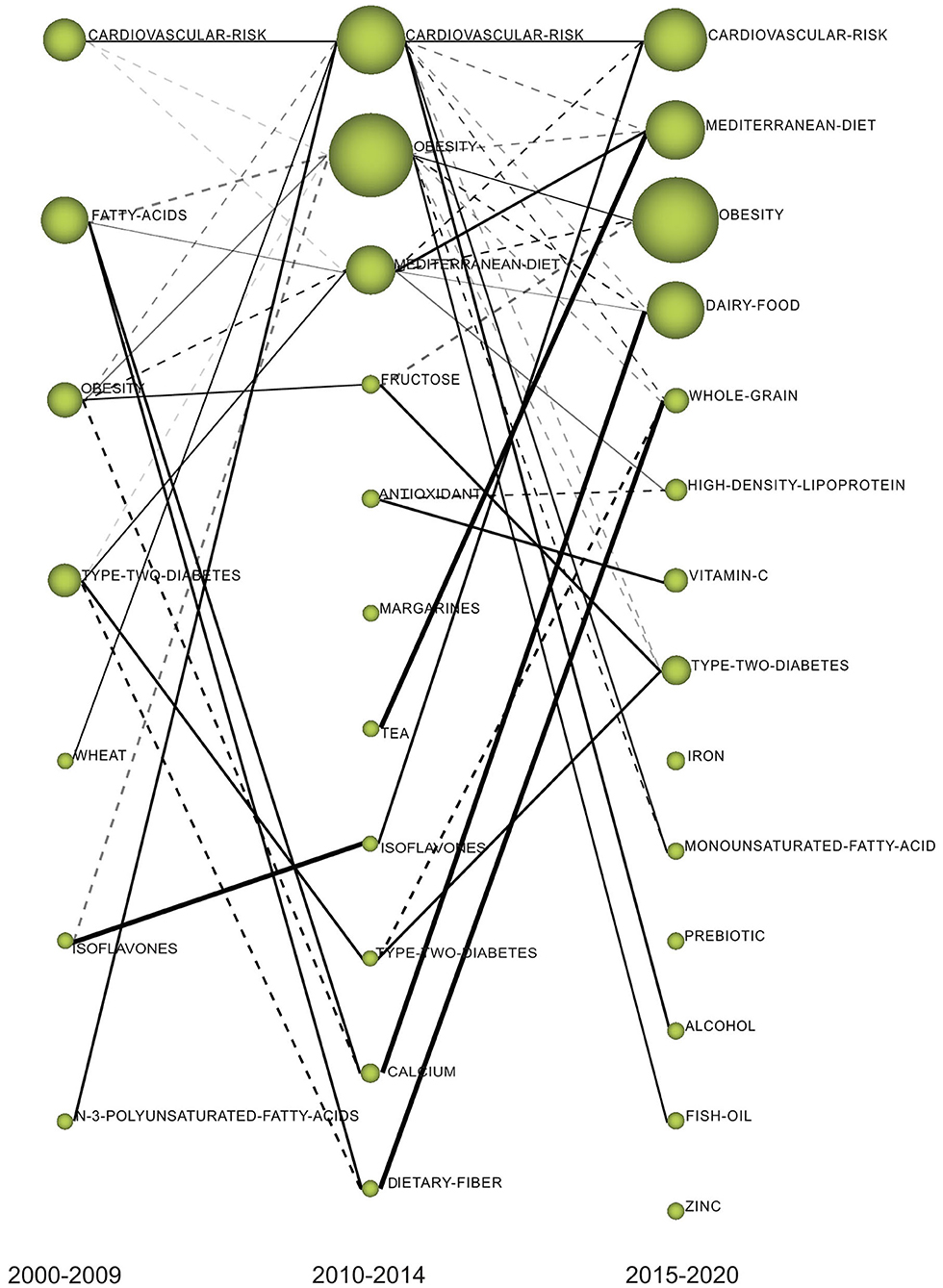- 1Department of Library, Shengjing Hospital of China Medical University, Shenyang, China
- 2Department of Clinical Epidemiology, Shengjing Hospital of China Medical University, Shenyang, China
- 3Department of Pediatrics, Pediatric Intensive Care Unit, Shengjing Hospital of China Medical University, Shenyang, China
Background: The global incidence of metabolic syndrome (MetS) is continuously increasing, making it a potential worldwide public health concern. Research on dietary factors related to MetS has attracted considerable attention in the recent decades. However, the research hotspots, knowledge structure, and theme trends for the dietary factors associated with MetS remain unknown, and have not yet been systematically mapped. This study aimed to review the research status of diet as a risk factor for MetS through bibliometric methods. Bibliometric analysis was conducted using the Web of Science database. Research hotspots were identified using biclustering analysis with the gCLUTO software, and knowledge structure was explored via social network analysis using the Ucinet software. Theme trends were investigated using evolutionary analysis with the SciMAT software. In total, 1,305 papers were analyzed. The research output on the dietary factors associated with MetS increased steadily. The research scope was gradually expanding and diverse. Overall, eight research hot spots, four key dietary nodes, and four motor themes on the dietary factors associated with MetS were identified. Fatty acids, dietary fiber, and polyphenols have been the focus of research in this field over the years. Evolutionary analysis showed that fish oil and vitamin C were well-developed research foci recently. Prebiotics was recognized as an emerging theme with certain developmental potential. These findings provide a better understanding of the research status of the dietary factors associated with MetS and a reference for future investigations.
Introduction
Metabolic syndrome (MetS) is a multicomponent disorder comprising at least three metabolic parameters including increased waist circumference, low high-density lipoprotein (HDL) cholesterol level, impaired fasting glucose level, elevated blood pressure, and elevated triacylglycerol levels. MetS is associated with a high risk of both type 2 diabetes and cardiovascular disease (CVD) (1–3). The increasing global incidence of MetS makes it a public health concern. National Health and Nutrition Examination Survey data from 2011 to 2016 show that ~34.7% of US adults have MetS (4). In Europe, the prevalence of MetS has reached 24.3% (5). A systematic review found a pooled prevalence rate of 24.5% among subjects aged 15 years and older in China (6).
The occurrence of MetS is related to both environmental and genetic factors, and dietary factors play a major role in the cause and management of the syndrome (7, 8). Evidence has demonstrated that diet and exercise are effective and complementary in the treatment of MetS and its underlying components (9). Accordingly, there have been numerous studies on the dietary factors associated with MetS. Foods, such as fruits, vegetables, whole-grains, soybean, tea, milk, and lipids, and vitamin supplements have been investigated for their potential influence on the MetS (10–16). Several reviews have summarized the growing evidence of the role of dietary patterns, consumption of fat, whole-grains, quality and quantity of carbohydrates, moderate alcohol consumption, etc. in the development and prevention of MetS (17–19). Based on the analysis of the association of dietary factors with MetS, an extensive range of strategies to reduce the occurrence of MetS have been suggested, including regular physical activity (20), limiting the intake of total carbohydrate (21), total fat, saturated fatty acid (22), red meat (23), etc.; and increasing dietary ingestion of fruits, vegetables, fish, polyphenols (24), monounsaturated fatty acids (25), etc. However, no study has provided a comprehensive overview on the current trends, primary areas of emphasis, and changes in research themes on the dietary factors associated with MetS.
Bibliometric analysis and visualization analysis are well-established research methods in information science, which are widely used in many scientific fields [e.g., neural stem cells research (26), environmental health (27), and production management (28)]. Recent developments in bibliometrics analysis software tools have made scientific mapping and quantitative analysis more accessible. Given the significant progress in understanding the dietary factors related to MetS, quantitative and qualitative evaluation of scientific achievements will help to understand the development status, research interests, and current trends in this field. Therefore, the primary purpose of this study was to map the hotspots, knowledge structure, and theme trends of this field in the past two decades (2000–2020), using the biclustering analysis of word co-occurrence with gCLUTO software, social network analysis of highly frequent keywords and highly cited papers with Ucinet software, and theme evolutionary analysis of research themes with SciMAT software. Further, this study explored the factors behind the hot research topics and theme evolution that have propelled the recent progress in this field, and points out some possible research directions in the future. These findings can help researchers keep up with the relevant developments to understand this field better and provide some hints for researchers when launching new projects.
Materials and Methods
Data Resource and Search Strategy
The Web of Science (WoS) database was searched for relevant studies on the dietary factors associated with MetS from 2000 to 2020, with no restrictions on language. The following search strategy was used: TS = (“metabolic syndrome” OR MetS OR “Insulin Resistance Syndrome X” OR “Metabolic X Syndrome” OR “Metabolic Cardiovascular Syndrome” OR “Reaven Syndrome X” OR “Dysmetabolic Syndrome X”) AND TS = (diet OR dietetic OR dietary OR food OR foods). The search was carried out on July 22, 2020.
Included studies met the following criteria: (1) human studies; (2) article or review; (3) focused on the study of dietary factors associated with MetS. All 22,392 records retrieved from Web of Science were imported into NoteExpress version 3.2.0.7535 to process the papers (29). The basic information from each paper, such as title, author, literature source, abstract, keywords, publishing date, et al., was recognized. Two reviewers (X-S L and Y-X C) independently evaluated and studied each of the papers according to the inclusion criteria. Any disagreements were discussed and resolved with a third reviewer (XC) until a consensus was reached. The agreement rate between them was 0.90, indicating a high consistency.
Data Extraction and Bibliographic Matrix Building
Bibliographic Item Co-Occurrence Matrix Builder (BICOMB; version 2.0) (30) was used to extract data and for matrix construction. This software can generate a co-occurrence matrix that can be used as basic data for subsequent analyses. In this study, we mainly use BICOMB to construct a term-article matrix, highly frequent keywords, and highly cited papers co-occurrence matrixes, and data cleaning was carried out before processing. The singular and plural forms of the keywords were merged, and spelling errors were also checked manually. The keywords with different spelling but similar meaning were combined, and those without relevant value to the study were deleted. Thereafter, a binary matrix with highly frequent keywords as the rows and source papers as the columns, was built through BICOMB for further analysis. In addition, the amount of highly frequent keywords was defined according to the threshold value (T), calculated as: (2)T= (1)/2 (31), where i represents the number of keywords with a frequency of 1. Highly frequent keywords were defined as those occurring at least nine times according to the calculated T value.
Hirsch proposed the h-index to quantify the scientific research output and academic level of scientists (32). Similarly, aco-citationanalysis was used to select highly cited papers to reflect the knowledge base of a certain research field (33), so the h-index can also reflect the contribution value of highly cited papers to all of the references in a given field. The h-index was determined as follows: the references in the list were sorted in descending order of citation frequency; n was the sequence number of each term; under the premise that the number of citations of the nth paper was less than or equal to n, the h-index was the maximum n value (32).
Biclustering Analysis
The gCLUTO software version 1.0 (Graphical CLUstering Toolkit, a graphical front-end for the CLUTO data clustering library, developed by Rasmussen, Newman, and Karypis from University of Minnesota) (34) was used for biclustering analysis. The repeated bisection was selected as the clustering method, I2 as the optimization function, and cosine function as the similarity coefficient, and the default values were selected for the remaining parameters. To obtain the best number of clusters, we used different numbers of clusters for biclustering. The biclustering result of the matrix of highly frequent keywords-source papers was shown through matrix visualization. The clustering effect was verified with mountain visualization. The research hotspots of dietary factors associated with MetS were identified by analyzing the semantic relationship among the keywords and the research focus of representative papers.
Social Network Analysis
Social network analysis (SNA) is a research tool that has been widely applied in sociology, psychology, economics, and management in recent years. This method is used to analyze the co-authorship network, citation network, and co-word network in scientific research (35). In our study, SNA was used to analyze the co-keywords and co-citation networks on the dietary factors associated with MetS. Using the highly frequent keywords and highly cited papers co-occurrence matrixes generated by BICOMB, the relationship between them were visualized with Ucinet software (version 6.186) (36). Keyword co-occurrence means that when two keywords that can express the research topic appear in the same paper, there is a certain internal relationship between the two words, and the higher their frequency, the closer is the relationship (37). Therefore, the frequency of keyword co-occurrence in the same paper can form a co-keywords network composed of these keyword pairs. Similarly, when two papers appear in the reference list of a third paper simultaneously, the two papers become co-cited. Moreover, the more times the two papers are co-cited, the more significant their correlation and the more likely they tend to discuss a similar topic (38). In the visualization network, the keywords (cited papers) were represented by nodes. The connection between keywords (cited papers) was represented by edges, with the co-occurrence frequency shown by the links. The strength of the relationship between the keywords (cited papers) was represented by the thickness of the line. The stronger the relationship between two keywords (cited papers), the thicker the line connecting them. The location of nodes was determined by the centrality index (i.e., degree, betweenness, and closeness). Distributing the nodes in the network clearly presents the knowledge structure on the dietary factors associated with MetS.
Theme Evolutionary Analysis
We used the Science Mapping Analysis software Tool (SciMAT; version 1.1.04) (39), which is an open source science mapping software tool developed at University of Granada, to describe the thematic and conceptual evolution in this field. According to the amount of literature, the literature was divided into three consecutive periods: 2000–2009, 2010–2014, and 2015–2020. Configuration was performed as follows: words as the unit of analysis (author and source); 2,3,3 as the threshold of data frequency reduction in each period; co-occurrence as the matrix form; 2,3,3 as the threshold of data network reduction in each period; association strength as the similarity measure to normalize the network; and the simple centers algorithm as the clustering algorithm. The bibliometric measures were selected using the h-index, and these measures were calculated using the core document mappers. Jaccard's Index and Inclusion Index were selected as the measures for the longitudinal map (40).
The longitudinal analysis was shown using an overlapping map and an evolution map, which helped us detect the evolution of the clusters throughout different periods and to study the transient and new keywords in each period and the keywords shared by two consecutive periods (41). The strategic diagram, a two-dimensional graph composed of the x- and y-axes, is used to describe the internal connection and mutual influence of a certain research field (42). In this study, the x-axis in the diagram represented centrality, which measured the external interaction between the theme clusters and could be understood as the theme's relevance value. Meanwhile, the y-axis represented density, which measured the theme cluster's internal cohesion and could be interpreted as a measure of the theme's development.
The detailed process of literature retrieval, study selection, and bibliometric analysis is shown in Figure 1.
Results
Growth of the Literature
Overall, 1,305 papers were included in the analysis. The distribution of the publication year is shown in Figure 2. For comparison, all papers on MetS in WoS are also mentioned in the figure.
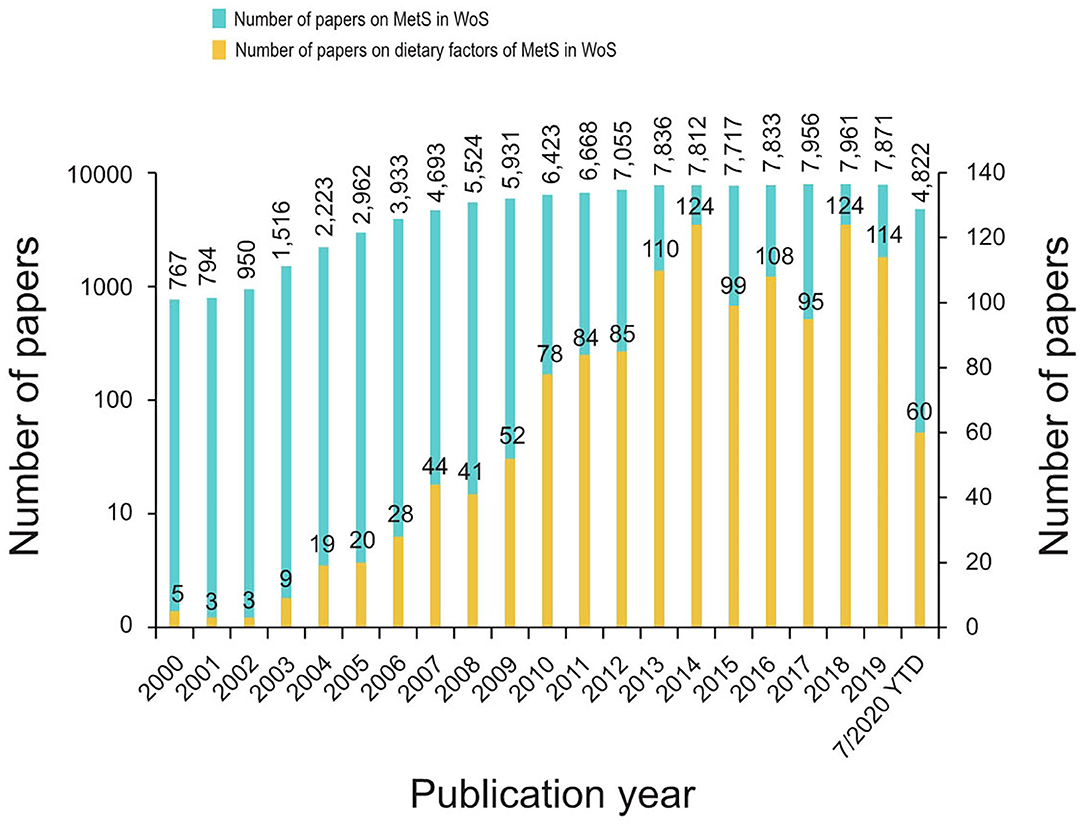
Figure 2. The number of papers on dietary factors of MetS and all papers on MetS in WoS from 2000 to 2020.
Research Hotspots of Dietary Factors Associated With MetS
A total of 57 highly frequent keywords, accounting for 37.36% of all keywords, were extracted from the included papers (Supplementary Table 1). Based on the co-occurrence of highly frequent keywords, a matrix with highly frequent keywords as rows and source papers as columns was established. The “1” and “0” in the matrix indicate that the highly frequent keyword was present and absent in the paper, respectively (Supplementary Table 2).
The biclustering result of the matrix was shown as matrix visualization and mountain visualization. The visualization matrix illustrated the clustering results of highly frequent keywords and source papers (Figure 3A). Row clustering indicated the clustering of highly frequent keywords, which were listed on the right side of the matrix. Column clustering represented the source papers. The highly frequent keywords were divided into five clusters (Figure 3A) (0–4, 5 clusters in total), and the clustering effect was verified using mountain visualization (Figure 3B), in which the volume of the peak was proportional to the number of highly frequent keywords contained in the cluster, and the height was proportional to the similarity within the cluster. The greater the similarity within the cluster, the steeper the mountain. A detailed reading of the highly frequent keywords in each cluster helped summarize the research topics of clustering. Finally, the research hotspots of the dietary factors associated with MetS were identified.
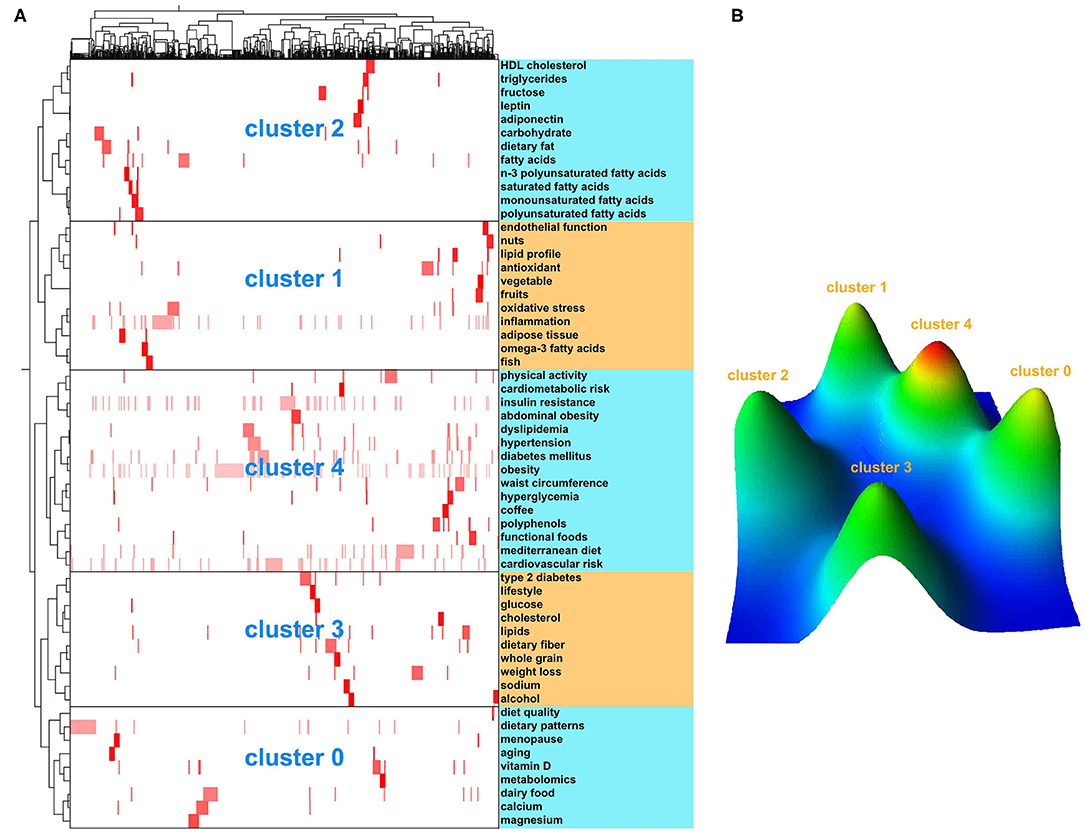
Figure 3. The biclustering result of highly frequent keywords and source papers on dietary factors of MetS. (A) Matrix visualization of biclustering of highly frequent keywords and source papers on dietary factors of MetS; (B) Mountain visualization of biclustering of highly frequent keywords and source papers on dietary factors of MetS.
In addition to analyzing the semantics of keywords and the contents of the representative papers in each cluster, some clusters were further divided into narrower topics. Each of these topics was summed up as a single hotspot. Overall, eight hotspots were identified: (1) effect of vitamin D intake on MetS (cluster 0), (2) effect of calcium intake on MetS (cluster 0), (3) effect of nut consumption on lipid profiles, oxidative stress, and endothelial function in MetS (cluster 1), (4) effect of fruit and vegetable consumption on endothelial function in MetS (cluster 1), (5) relationship between fatty acid composition and MetS (cluster 2), (6) effect of dietary fiber on MetS (cluster 3), (7) effect of coffee consumption on MetS (cluster 4), and (8) association between dietary polyphenols and MetS (cluster 4).
Knowledge Structure
In the co-occurrence network, the node located in the center of the network is the most active, having more connections than other nodes and playing an important role in network connectivity. Node importance was evaluated according to three classic indicators of SNA, namely, degree centrality, betweenness centrality, and closeness centrality (43, 44). The node size was proportional to the degree centrality of a keyword, with the line thickness representing the co-occurrence frequency. Node color was classified according to the three indicators.
The highly frequent co-occurrence keyword network is shown in Figure 4. Table 1 shows the top 20 nodes in the network centrality of the dietary factors associated with MetS. The nodes with a high of degree centrality, betweenness centrality, and closeness centrality were overlapping and repetitive. These nodes included obesity, insulin resistance, cardiovascular risk, inflammation, and diabetes mellitus. They played an important intermediary role in the flow and control of network resources. The key dietary nodes, including fatty acids, polyphenols, dairy food, and dietary fiber, were also screened out using the network evaluation indicators. The centrality of the 57 highly frequent keywords is shown in Supplementary Table 3.
The h-index in this field was calculated as 40. Based on this value, the top 40 papers with highest citation frequency were selected as highly cited papers in the list of references (Supplementary Table 4). The co-citation network of 40 highly cited papers well-reflects the structure of the knowledge base in this research field (Supplementary Figure 1). The centrality of the 40 highly cited papers was shown in Supplementary Table 5. To make the network more concise and intuitive, the paper pairs co-occurrence threshold was set to be ≥30 times; then, two network structures were extracted (Figure 5). As seen in Figure 5, “Grundy SM, 2005, CIRCULATION, V112, P2735” was located in the network's core with the highest centrality of degree, betweenness, and closeness. Furthermore, “Grundy SM, 2005, CIRCULATION, V112, P2735” and “Cleeman JI, 2001, JAMA-J AM MED ASSOC, V285, P2486” had the highest co-occurrence frequency, followed by “Grundy SM, 2005, CIRCULATION, V112, P2735” and “Alberti KGMM, 2009, CIRCULATION, V120, P1640.” Moreover, “Pereira MA, 2002, JAMA-J AM MED ASSOC, V287, P2081” and “Azadbakht L, 2005, AM J CLIN NUTR, V82, P523” document pairs formed an isolated structure, separated from the principal component.
Theme Evolution
Thematic Overlapping Map
The overlapping map shows the change in research themes and the stability of the research fields in the form of data flow. The circles represent the time periods, and the figure in the circle represents the number of themes in the corresponding period. The horizontal arrow between the two circles indicates the continuity of the two periods. The number on the arrow represents the number of themes shared by the two periods, and the value in brackets is the stability index, which was used to measure the overlap between the two periods. The upper incoming arrow represents the number of new themes in a given time period, and the upper outgoing arrow represents the themes presented in this period, but not in the next period.
Figure 6 shows the evolution of dietary factors associated with MetS in the past 20 years divided into three periods (from left to right): 2000–2009, 2010–2014, and 2015–2020. The new themes were larger than the declining themes in each period, the total number of themes and the stability index were continuously improved, and the number of themes studied was preserved from the previous to the next period.
Strategic Diagrams
In the strategic diagrams, four different quadrants could be distinguished based on their positions on the map. The cluster in Quadrant I (upper right) indicates themes that were well-developed as motor themes in the network; Quadrant II (upper left), research maturity was high but had marginal importance for the field (i.e., highly developed and isolated themes); Quadrant III (lower left), research maturity was low and in the marginal position (i.e., generally emerging or declining themes); and Quadrant IV (lower right), research was in the central position but not mature and had great developmental potential (i.e., basic and transversal themes) (Figure 7A) (28, 41). The size of a signal node in the diagrams was proportional to the number of documents involved in each cluster. The quantitative data of nodes based on other performance methods are shown in Supplementary Table 6.
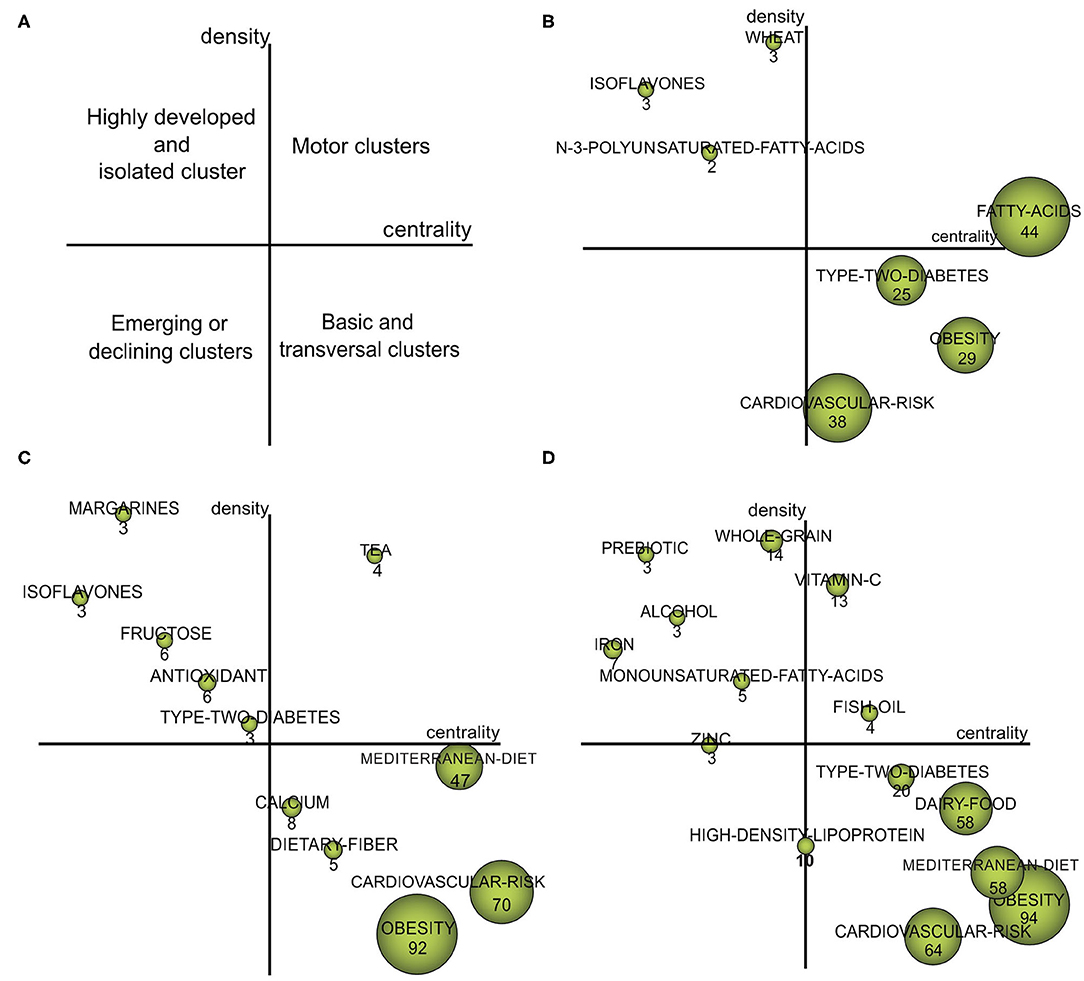
Figure 7. Strategic diagrams for dietary factors of MetS. (A) The interpretation of the strategic diagram; (B) Strategic diagram of dietary factors of MetS from 2000 to 2009; (C) Strategic diagram of dietary factors of MetS from 2010 to 2014; (D) Strategic diagram of dietary factors of MetS from 2015 to 2020.
The motor themes of each period differed, as shown by the strategic diagrams. The motor theme of the first period (2000–2009) was “FATTY-ACIDS” (Figure 7B). In the second period (2010–2014), researchers shifted their focus to “TEA” research (Figure 7C). In the third period (2015–2020), attention was given to “VITAMIN-C” and “FISH-OIL” (Figure 7D).
Thematic Evolution Map
In the thematic evolution map shown in Figure 8, the nodes represent the clustering of themes in a certain period, the size of nodes is proportional to the number of documents associated with each cluster, and the thickness of the edges represents the closeness of the two clustering themes. The solid line represents the linked clustering themes sharing the main analysis units (keywords), which indicate that the two themes are persistent and represent the evolution direction of the mainstream. The dotted line indicates the themes sharing elements that were not the main analysis units, representing the evolution direction of tributaries. The thicker the connection of the two theme clusters, the higher their correlation strength and the stronger the evolutionary ability. The isolated node represents the theme that appeared only in a certain period and had no relationship with the theme of the previous and later periods. These isolated nodes reflected, to some extent, the new themes.
“FATTY-ACIDS” shared the main keywords with “MEDITERRANEAN-DIET,” “CALCIUM,” and “DIETARY-FIBER.” In the 2015–2020 period, the “MEDITERRANEAN-DIET” was promoted to second place from the third place. “MEDITERRANEAN-DIET” was strongly related with “TEA,” as indicated by the thick solid lines. “CALCIUM” continued to evolve into “DAIRY-FOOD,” and “DIETARY-FIBER” evolved into “WHOLE-GRAIN.” The three themes of “IRON,” “PREBIOTIC,” and “ZINC” had no connection with the previous themes and were thus recognized as emerging themes.
Discussion
Information on the current trends, research hotspots, and changes in research themes on the dietary factorsassociated with MetS is limited. In this study, the trends over the past 20 years in research in WoS specifically on the dietary factors associated with MetS were consistent with those in research on MetS in general. From 2000 to 2002, which was the early stage of this discipline's development, only a small number of studies on the dietary factors associated with MetS were published. From 2003 to 2012, the volume of research increased significantly with the in-depth study of MetS. After 2013, the research entered a relatively mature stage, and the number of published papers tended to plateau. In contrast, the average growth rate of studies on the dietary factors associated with MetS was significantly higher than that of overall research on MetS, suggesting that the study of dietary factors became a major focus of MetS research. Further, this indicated that the research scope of MetS dietary factors was gradually expanding, with the research tending to be mature and continuous.
The themes of cardiovascular risk, obesity, and Mediterranean diet were persistently investigated throughout the study period. They were located in the center of the network, with high frequency. These findings indicated that these themes not only were closely related to MetS, but also played a crucial mediating role in the diet network of MetS. These results indicate an overall direction in this research field: controlling obesity through healthy diets to reduce MetS and ultimately achieve the overall goal of reducing the risk of CVD. CVD remains the leading cause of morbidity and mortality, causing a significant disease burden worldwide. Each component of the MetS is an independent risk factor for CVD (45). It is well-accepted that obesity is a risk factor for multiple diseases and a key etiological factor in the development of MetS. Diet intervention is the cornerstone of weight loss treatment. Our results reflect that increasingly, studies are focusing on the Mediterranean healthy diet, which has shown a protective effect on MetS. In the evolutionary map, the Mediterranean diet had become the second most common research theme in the most recent period. This suggested that more people are now focusing on their health by adopting a healthy diet to prevent MetS. Furthermore, dietary intervention alone is not an effective way to control obesity. Physical activity is vital for maintaining weight loss achieved through diet.
References provide the main source of knowledge for scientific research and exploration (46). Therefore, by analyzing the co-occurrence relationships of highly cited papers from the reference list, the knowledge base of this field can be visualized. From the center of the knowledge base map, it can be seen that the papers on diagnostic criteria and definition of MetS were most commonly co-cited, and these papers had high co-occurrence with studies on the association of CVD with MetS, MetS prevalence, and dietary role on MetS. These topics usually appeared in the introduction of the studies on dietary factors of MetS. Thus, the first knowledge base was also the necessary knowledge background for researchers to launch new projects in this field. The second knowledge base captured from the map was the dietary pattern, especially the Mediterranean diet. In addition, we found that polyphenols were research hotspots and a key dietary node in the knowledge structure network. Tea (polyphenol-rich foods) became the motor theme, with strong evolutionary ability in the second period, and it further evolved into Mediterranean diet (Supplementary Figure 2). This may be attributed to findings that the beneficial effect of the Mediterranean diet against MetS was related to the high content of bioactive substances and polyphenols (47, 48). Another knowledge base reflected from the map was the relationship between dairy foods and MetS, which provides an important reference for the further research of milk, yogurt, calcium, vitamin D, potassium, and so on. Furthermore, the evolutionary analysis showed that calcium has become an important research topic in 2010–2014, which was usually studied with vitamin D (Supplementary Figure 3). However, our results showed that calcium appeared in Quadrant IV, which means that calcium was yet to be fully developed in the corresponding period. The effect of dietary calcium on MetS has not been completely clarified. Therefore, the research on the mechanism of the nutrients in dietary patterns and foods, such as polyphenols, calcium, and vitamin D, in the occurrence and development of MetS might influence the future direction of this field.
The results of biclustering analysis and SNA showed that fatty acids, dietary fiber, and polyphenols not only were the research hotspots, but also had high centrality in the co-occurring keyword network. We also identified fatty acids as a motor theme with high centrality and influence on other themes in the 2000–2009 diagrams. Significantly, the research of n-3 polyunsaturated fatty acids (n-3 PUFAs) was relatively mature. The fact that fatty acids as study hotspots were quantitatively relevant may be because of the following reasons: (1) fat is an important macronutrient to supply energy, which is crucial for human health, and fatty acids are the main component of fat (49). (2) fatty acids exist widely in different foods and are easily available. (3) high energy fatty foods cost less (4)fatty acid intake is essential for human body. (5) different types of fatty acids have significant roles in the evolution or the prevention of the MetS. The World Health Organization (WHO) recommends limiting the intake of fatty acids to <30% of energy intake (50). In the recent decades, the fat intake of developing countries has increased, while that of developed countries has decreased (51). Further, most of the research is concentrated in western developed countries. Therefore, with the change of eating habits, in-depth study of different types of fatty acids, and the rise of metabonomics research, the study of fatty acids, began to evolve.
The evolution process showed that the studies of fatty acids further evolved into studies on dietary fiber and calcium (Supplementary Figure 3). Dietary fiber is generally not digested and absorbed by the stomach and small intestine, but can be fermented by intestinal flora, which plays a vital role in maintaining their homeostasis, the balance of intestinal mucus generation and degradation, and the protection of the intestinal wall structure (52). Based on the development of metagenomic sequencing and metabonomics analysis in the recent years, the research of dietary fiber, intestinal flora, and their relationship with human health has been of primary concern for scientists. Previous studies inferred that dietary fiber may play an important role in the dietary management of MetS (53); however, the mechanism by which fiber exerts a beneficial effect on MetS components has not been well-elucidated. Similarly, based on the strategic diagram, dietary fiber was identified as the basic and transversal theme during 2010–2014, indicating that it was related to MetS, but research on this theme is yet to be fully developed. To our knowledge, it is worthwhile for researchers to combine metabonomics to monitor the regulatory effect of dietary fiber on intestinal flora and intestinal environment, and further discover the mechanism of dietary fiber in MetS for the future.
From 2015 to 2020, the motor theme gradually changed from tea to fish oil and vitamin C. The main factor mediating this transformation may be their antioxidant characteristics. Fish oil and omega-3 fatty acids are closely related (Supplementary Figure 4). Careful examination of vitamin C showed that it was closely related to vegetables, fruits, carotenoids, and antioxidants (Supplementary Figure 5). Antioxidants in foods can protect cells and tissues from oxidative damage by inducing endogenous antioxidant defense (54). The concept of nutritional antioxidants originated from the oxidized low density lipoprotein (LDL) theory of atherosclerosis (55). A higher concentration of oxidized LDL was found to be associated with increased risk of MetS (56). Oxidative stress is critical to the initiation and progression of MetS. In the future, the identification of more key oxidative/antioxidant targets and biomarkers will contribute to the treatment of MetS with antioxidants.
Iron, zinc, and prebiotics appeared independently in the third period, which indicated that they may be emerging themes. However, as shown in our strategic diagrams, studies on iron and zinc might be traced back to an earlier period. In the recent years, with the development of metabolomics and 16S rRNA technology, the role of intestinal microbes in health and disease has been recognized in alternative and complementary forms of medicine (57), and researchers' interest in prebiotics has extended beyond iron and zinc. In comparison, prebiotics are more likely to be emerging themes in recent years. Prebiotics are dietary components beneficial to bacterial growth and metabolic activities. Supplementation of prebiotics can better regulate the intestinal flora and promote the development of the intestinal microecology. With respect to dietary prebiotics and probiotics, previous studies have shown that they may modify the gut microbiota and hence attenuate the symptoms of MetS (58, 59). Intestinal microbiota are an ideal target for MetS management through supplementation with probiotics and prebiotics (60). Due to the remarkable progress of 16S rRNA sequencing technology, there has been a tremendous increase in studies on the composition and diversity of human intestinal microbiota in the past decade. Prebiotics are not absorbed by the intestine, and they can better facilitate the growth of intestinal probiotics and the metabolism of lipid and protein. Metabonomics is a crucial method to detect metabolites (fat, protein, etc.), especially 16S rRNA sequencing, which has substantial advantages in monitoring intestinal microflora and intestinal microbial status (probiotics and prebiotics). Detecting the beneficial or harmful changes of the internal environment by 16S rRNA is helpful to elucidate the pathogenesis of metabolic diseases. Technological innovation has dramatically promoted the research of prebiotics in the field of metabolism. However, data on the function of prebiotics on intestinal microbiota and their relationship with MetS are still inadequate to prove that they can be used in clinical practice to prevent and manage MetS. This highlights the need for further research on the potential benefit of prebiotics for the prevention and treatment of MetS.
This study has some limitations. First, data were only collected from a single database (i.e., WoS), and thus, other studies from other databases were not analyzed. Second, we only included articles and reviews; as such, other research hotspots may have been missed. Third, biclustering analysis and SNA were performed based on highly frequent keywords. This led to some new, but less frequent, topics being ignored. Last, visualization tools, such as gCLUTO, Ucinet, and SciMAT, can only process data from one database at a time, which may lead to biased results.
Despite these limitations, to our best knowledge, this is the first study to apply biclustering analysis, SNA, and evolutionary analysis to comprehensively evaluate the relationship between dietary factors and MetS. This allowed us to determine the overall research hotspots and knowledge structure from a statistical point of view and the dynamic changes in research themes.
In conclusion, fatty acids, dietary fiber, and polyphenols are the main focus of research on the dietary factors associated with MetS. To further improve research, scientists should pay more attention on vitamin C and fish oil. Prebiotics was recognized as an emerging theme with certain developmental potential. These findings provide a better understanding of the research hotspots on the dietary factors associated with MetS, and the findings can be used as basis for future investigations on MetS. The application of bibliometrics should be expanded in further studies on MetS.
Data Availability Statement
The raw data supporting the conclusions of this article will be made available by the authors, without undue reservation.
Author Contributions
XC: reviewing the results for study inclusion, performing most assays, and writing-original draft preparation. Q-JW and QC: reviewing and revising of the manuscript. T-NZ: writing-reviewing and editing. X-SL and Y-XC: performing the literature search and reviewing the results for study inclusion. Y-HZ: contributed to the approval of the final version of the manuscript. All authors contributed to the article and approved the submitted version.
Funding
This study was supported by the National Key R&D Program of China (2017YFC0907400 to Y-HZ).
Conflict of Interest
The authors declare that the research was conducted in the absence of any commercial or financial relationships that could be construed as a potential conflict of interest.
Acknowledgments
We are grateful to all the participants of the study.
Supplementary Material
The Supplementary Material for this article can be found online at: https://www.frontiersin.org/articles/10.3389/fnut.2021.655533/full#supplementary-material
References
1. Lakka HM, Laaksonen DE, Lakka TA, Niskanen LK, Kumpusalo E, Tuomilehto J, et al. The metabolic syndrome and total and cardiovascular disease mortality in middle-aged men. JAMA. (2002) 288:2709–16. doi: 10.1001/jama.288.21.2709
2. Laaksonen DE, Lakka HM, Niskanen LK, Kaplan GA, Salonen JT, Lakka TA. Metabolic syndrome and development of diabetes mellitus: application and validation of recently suggested definitions of the metabolic syndrome in a prospective cohort study. Am J Epidemiol. (2002) 156:1070–77. doi: 10.1093/aje/kwf145
3. Executive Summary of the Third Report of the National Cholesterol Education Program (NCEP) Expert Panel on detection evaluation, and treatment of high blood cholesterol in adults (Adult Treatment Panel III). JAMA. (2001) 285:2486–97. doi: 10.1001/jama.285.19.2486
4. Hirode G, Wong RJ. Trends in the prevalence of metabolic syndrome in the United States, 2011-2016. JAMA. (2020) 323:2526–28. doi: 10.1001/jama.2020.4501
5. Scuteri A, Laurent S, Cucca F, Cockcroft J, Cunha PG, Manas LR, et al. Metabolic syndrome across Europe: different clusters of risk factors. Eur J Prev Cardiol. (2015) 22:486–91. doi: 10.1177/2047487314525529
6. Li R, Li W, Lun Z, Zhang H, Sun Z, Kanu JS, et al. Prevalence of metabolic syndrome in Mainland China: a meta-analysis of published studies. BMC Public Health. (2016) 16:296. doi: 10.1186/s12889-016-2870-y
7. Meigs JB. Epidemiology of the metabolic syndrome, 2002. Am J Manag Care. (2002) 8:S283–92, S293–96.
8. Wirfalt E, Hedblad B, Gullberg B, Mattisson I, Andren C, Rosander U, et al. Food patterns and components of the metabolic syndrome in men and women: a cross-sectional study within the Malmo Diet and Cancer cohort. Am J Epidemiol. (2001) 154:1150–9. doi: 10.1093/aje/154.12.1150
9. Janssen I, Fortier A, Hudson R, Ross R. Effects of an energy-restrictive diet with or without exercise on abdominal fat, intermuscular fat, and metabolic risk factors in obese women. Diabetes Care. (2002) 25:431–8. doi: 10.2337/diacare.25.3.431
10. Costa E, Silva LM, Pereira De Melo ML, Faro Reis FV, Monteiro MC, Dos Santos SM, Quadros Gomes BA, et al. Comparison of the effects of Brazil nut oil and soybean oil on the cardiometabolic parameters of patients with metabolic syndrome: a randomized trial. Nutrients. (2020) 12:46. doi: 10.3390/nu12010046
11. Yonekura Y, Terauchi M, Hirose A, Odai T, Kato K, Miyasaka N. Daily coffee and green tea consumption is inversely associated with body mass index, body fat percentage, and cardio-ankle vascular index in middle-aged Japanese women: a cross-sectional study. Nutrients. (2020) 12:1370. doi: 10.3390/nu12051370
12. Hidayat K, Yu LG, Yang JR, Zhang XY, Zhou H, Shi YJ, et al. The association between milk consumption and the metabolic syndrome: a cross-sectional study of the residents of Suzhou, China and a meta-analysis. Br J Nutr. (2020) 123:1013–23. doi: 10.1017/S0007114520000227
13. Perona PS. Membrane lipid alterations in the metabolic syndrome and the role of dietary oils. Biochim Biophys Acta Biomembr. (2017) 1859:1690–703. doi: 10.1016/j.bbamem.2017.04.015
14. Godala M, Materek-Kusmierkiewicz I, Moczulski D, Rutkowski M, Szatko F, Gaszynska E, et al. The risk of plasma vitamin A, C, E and D deficiency in patients with metabolic syndrome: a case-control study. Adv Clin Exp Med. (2017) 26:581–6. doi: 10.17219/acem/62453
15. Hong SA, Kim MK. Relationship between fruit and vegetable intake and the risk of metabolic syndrome and its disorders in Korean women according to menopausal status. Asia Pac J Clin Nutr. (2017) 26:514–23. doi: 10.6133/apjcn.042016.03
16. Esmaillzadeh A, Mirmiran P, Azizi F. Whole-grain consumption and the metabolic syndrome: a favorable association in Tehranian adults. Eur J Clin Nutr. (2005) 59:353–62. doi: 10.1038/sj.ejcn.1602080
17. Djousse L, Padilla H, Nelson TL, Gaziano JM, Mukamal KJ. Diet and metabolic syndrome. Endocr Metab Immune Disord Drug Targets. (2010) 10:124–37. doi: 10.2174/187153010791213056
18. Almeda-Valdes P, Herrera-Mercadillo RJ, Aguilar-Salinas CA, Uribe M, Mendez-Sanchez N. The role of diet in patients with metabolic syndrome. Curr Med Chem. (2019) 26:3613–9. doi: 10.2174/0929867324666170518095316
19. Keane D, Kelly S, Healy NP, McArdle MA, Holohan K, Roche HM. Diet and metabolic syndrome: an overview. Curr Vasc Pharmacol. (2013) 11:842–57. doi: 10.2174/15701611113116660173
20. Kim J, Choi Y. Physical activity, dietary vitamin C, and metabolic syndrome in the Korean adults: the Korea National Health and Nutrition Examination Survey 2008 to 2012. Public Health. (2016) 135:30–7. doi: 10.1016/j.puhe.2016.01.002
21. Liu Y, Wu Q, Xia Y, Zhang J, Jiang Y, Chang Q, et al. Carbohydrate intake and risk of metabolic syndrome: a dose-response meta-analysis of observational studies. Nutr Metab Cardiovas. (2019) 29:1288–98. doi: 10.1016/j.numecd.2019.09.003
22. van Dijk SJ, Feskens EJM, Bos MB, Hoelen DWM, Heijligenberg R, Bromhaar MG, et al. A saturated fatty acid-rich diet induces an obesity-linked proinflammatory gene expression profile in adipose tissue of subjects at risk of metabolic syndrome. Am J Clin Nutr. (2009) 90:1656–64. doi: 10.3945/ajcn.2009.27792
23. Luan D, Wang D, Campos H, Baylin A. Red meat consumption and metabolic syndrome in the Costa Rica Heart Study. Eur J Nutr. (2020) 59:185–93. doi: 10.1007/s00394-019-01898-6
24. Finicelli M, Squillaro T, Di Cristo F, Di Salle A, Melone MAB, Galderisi U, et al. Metabolic syndrome, mediterranean diet, and polyphenols: evidence and perspectives. J Cell Physiol. (2019) 234:5807–26. doi: 10.1002/jcp.27506
25. Gillingham LG, Harris-Janz S, Jones PJH. Dietary monounsaturated fatty acids are protective against metabolic syndrome and cardiovascular disease risk factors. Lipids. (2011) 46:209–28. doi: 10.1007/s11745-010-3524-y
26. Wei WJ, Shi B, Guan X, Ma JY, Wang YC, Liu J. Mapping theme trends and knowledge structures for human neural stem cells: a quantitative and co-word biclustering analysis for the 2013-2018 period. Neural Regen Res. (2019) 14:1823–32. doi: 10.4103/1673-5374.257535
27. Dai S, Duan X, Zhang W. Knowledge map of environmental crisis management based on keywords network and co-word analysis, 2005-2018. J Clean Prod. (2020) 262:121168. doi: 10.1016/j.jclepro.2020.121168
28. Garcia-Buendia N, Moyano-Fuentes J, Maqueira-Marin JM, Cobo MJ. 22 Years of Lean Supply Chain Management: a science mapping-based bibliometric analysis. Int J Prod Res. (2020) 59:1901–21. doi: 10.1080/00207543.2020.1794076
29. Beijing Aegean Technology Co., Ltd. NoteExpress Documents Management Software. Beijing: Beijing Aegean Technology Co., Ltd. (2011).
30. Lei C. Development of a text mining system based on the co-occurrence of bibliographic items in literature databases. New Technol Library Inf Serv. (2008) 8:70–5. doi: 10.3969/j.issn.1003-3513.2008.08.013
31. Rosenberg B. Understanding scientific literatures: a bibliometric approach. Inform Storage Retrieval. (1974) 10:420–1. doi: 10.1016/0020-0271(74)90051-5
32. Hirsch JE. An index to quantify an individual's scientific research output. Proc Natl Acad Sci USA. (2005) 102:16569–72. doi: 10.1073/pnas.0507655102
33. Li F, Lei C. Using biclustering algorithm to explore the discipline frontier and knowledge base – Taking the research field of h-index as an example. Inform Stud Theory Appl. (2014) 37:55–60. doi: 10.16353/j.cnki.1000-7490.2014.11.007
34. Rasmussen M, Karypis G. gCLUTO - Graphical Clustering Toolkit. Minneapolis: University of Minnesota Twin Cities (2004).
35. Otte E, Rousseau R. Social network analysis: a powerful strategy, also for the information sciences. J Inf Sci. (2002) 28:441–53. doi: 10.1177/016555150202800601
36. Borgatti SP, Everett MG, Freeman LC. UCINET. In: Alhajj R, Rokne J, editors. Encyclopedia of Social Network Analysis Mining. New York, NY: Springer New York (2014).
37. Cambrosio A, Limoges C, Courtial JP, Laville F. Historical scientometrics? Mapping over 70 years of biological safety research with coword analysis. Scientometrics. (1993) 27:119–43. doi: 10.1007/BF02016546
38. Marshakova V. Citation networks in information science. Scientometrics. (1981) 3:13–25. doi: 10.1007/BF02021861
39. Cobo MJ, López-Herrera AG, Herrera-Viedma E, Herrera F. SciMAT: a new science mapping analysis software tool. J Am Soc Inform Sci Technol. (2012) 63:1609–30. doi: 10.1002/asi.22688
40. Peters HPF, van Raan AFJ. Co-word-based science maps of chemical engineering. Part I: Representations by direct multidimensional scaling. Res Policy. (1993) 22:23–45. doi: 10.1016/0048-7333(93)90031-C
41. Cobo MJ, López-Herrera AG, Herrera-Viedma E, Herrera F. An approach for detecting, quantifying, and visualizing the evolution of a research field: a practical application to the Fuzzy Sets Theory field. J Informet. (2011) 5:146–66. doi: 10.1016/j.joi.2010.10.002
42. Law J, Bauin S, Courtial JP, Whittaker J. Policy and the mapping of scientific change: a co-word analysis of research into environmental acidification. Scientometrics. (1988) 14:251–64. doi: 10.1007/BF02020078
43. Freeman LC. Centrality in social networks conceptual clarification. Soc Netw. (1978) 1:215–39. doi: 10.1016/0378-8733(78)90021-7
44. Sabidussi G. The centrality index of a graph. Psychometrika. (1966) 31:581–603. doi: 10.1007/BF02289527
45. O'Neill S, O'Driscoll L. Metabolic syndrome: a closer look at the growing epidemic and its associated pathologies. Obes Rev. (2015) 16:1–12. doi: 10.1111/obr.12229
46. Small H. Co-citation in the scientific literature: a new measure of the relationship between two documents. J Am Soc Inform Sci. (1973) 24:265–69. doi: 10.1002/asi.4630240406
47. Martinez-Gonzalez MA, Salas-Salvado J, Estruch R, Corella D, Fito M, Ros E. Benefits of the mediterranean diet: insights from the PREDIMED study. Prog Cardiovasc Dis. (2015) 58:50–60. doi: 10.1016/j.pcad.2015.04.003
48. Amiot MJ, Riva C, Vinet A. Effects of dietary polyphenols on metabolic syndrome features in humans: a systematic review. Obes Rev. (2016) 17:573–86. doi: 10.1111/obr.12409
49. Castro-Gomez P, Garcia-Serrano A, Visioli F, Fontecha J. Relevance of dietary glycerophospholipids and sphingolipids to human health. Prostag Leukotr Ess. (2015) 101:41–51. doi: 10.1016/j.plefa.2015.07.004
51. Visioli F, Poli A. Fatty acids and cardiovascular risk. Evidence, lack of evidence, and diligence. Nutrients. (2020) 12:3782. doi: 10.3390/nu12123782
52. van der Kamp JW, Harris PJ. Editorial for the special issue “dietary fibre: new insights on biochemistry and health benefits”. Int J Mol Sci. (2018) 19:3556. doi: 10.3390/ijms19113556
53. Chen J, Chen G, Wang X, Qin L, Bai Y. Dietary fiber and metabolic syndrome: a meta-analysis and review of related mechanisms. Nutrients. (2018) 10:24. doi: 10.3390/nu10010024
54. Forman HJ, Davies KJ, Ursini F. How do nutritional antioxidants really work: nucleophilic tone and para-hormesis versus free radical scavenging in vivo. Free Radic Biol Med. (2014) 66:24–35. doi: 10.1016/j.freeradbiomed.2013.05.045
55. Steinberg D, Parthasarathy S, Carew TE, Khoo JC, Witztum JL. Beyond cholesterol. Modifications of low-density lipoprotein that increase its atherogenicity. N Engl J Med. (1989) 320:915–24. doi: 10.1056/NEJM198904063201407
56. Holvoet P, Lee DH, Steffes M, Gross M, Jacobs DJ. Association between circulating oxidized low-density lipoprotein and incidence of the metabolic syndrome. JAMA. (2008) 299:2287–93. doi: 10.1001/jama.299.19.2287
57. Cheifetz AS, Gianotti R, Luber R, Gibson PR. Complementary and alternative medicines used by patients with inflammatory bowel diseases. Gastroenterology. (2017) 152:415–29. doi: 10.1053/j.gastro.2016.10.004
58. Brown L, Poudyal H, Panchal SK. Functional foods as potential therapeutic options for metabolic syndrome. Obes Rev. (2015) 16:914–41. doi: 10.1111/obr.12313
59. Da SS, Dos SC, Bressan J. Intestinal microbiota; relevance to obesity and modulation by prebiotics and probiotics. Nutr Hosp. (2013) 28:1039–48. doi: 10.3305/nh.2013.28.4.6525
Keywords: metabolic syndrome, diet, knowledge mapping, bibliometric analysis, biclustering analysis, social network analysis, evolutionary analysis
Citation: Cao X, Wu Q-J, Chang Q, Zhang T-N, Li X-S, Chen Y-X and Zhao Y-H (2021) Knowledge Mapping of Dietary Factors of Metabolic Syndrome Research: Hotspots, Knowledge Structure, and Theme Trends. Front. Nutr. 8:655533. doi: 10.3389/fnut.2021.655533
Received: 19 January 2021; Accepted: 11 May 2021;
Published: 31 May 2021.
Edited by:
Maria Ines Isla, Universidad Nacional de Tucumán, ArgentinaCopyright © 2021 Cao, Wu, Chang, Zhang, Li, Chen and Zhao. This is an open-access article distributed under the terms of the Creative Commons Attribution License (CC BY). The use, distribution or reproduction in other forums is permitted, provided the original author(s) and the copyright owner(s) are credited and that the original publication in this journal is cited, in accordance with accepted academic practice. No use, distribution or reproduction is permitted which does not comply with these terms.
*Correspondence: Yu-Hong Zhao, emhhb3l1aG9uZ0Bzai1ob3NwaXRhbC5vcmc=
 Xia Cao
Xia Cao Qi-Jun Wu
Qi-Jun Wu Qing Chang2
Qing Chang2 Tie-Ning Zhang
Tie-Ning Zhang Yu-Hong Zhao
Yu-Hong Zhao